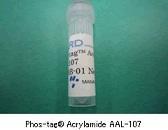

For the separation of phosphorylated proteins by SDS-PAGE Phos-tag™ Acrylamide
Phos-tag™ SDS-PAGE can be performed to separate phosphorylated and non-phosphorylated proteins by mixing Phos-tag™Acrylamide with acrylamide solution to allow for polymerization to occur.
Features
- It can be used regardless of the type and position of amino acid residues.
Able to analyze unknown phosphoproteins.
Able to detect new phosphorylation sites for which anti-phospho antibodies are not commercially available. - Phosphorylated forms with different number and location of phosphorylated sites can be separated.
Able to determine the level of phosphorylation and the number of phosphorylated forms. - It can be used to detect phosphorylated and non-phosphorylated forms simultaneously.
Able to quantify each phosphorylated form.
Able to determine the presence of phosphorylation easily. - Radioisotopes and special equipment are not needed.
Experiments can be carried out easily at low costs (Only SDS-PAGE reagents and equipment are required). - After electrophoresis, WB- and MS-based analyses and 2D gel electrophoresis can be performed.
WB: Internal proteins can be analyzed.
MS: The combinations of phosphorylated sites for each phosphorylated form can be determined.
2D gel electrophoresis: Phosphorylated forms with identical isoelectric points or molecular weights can be separated.
